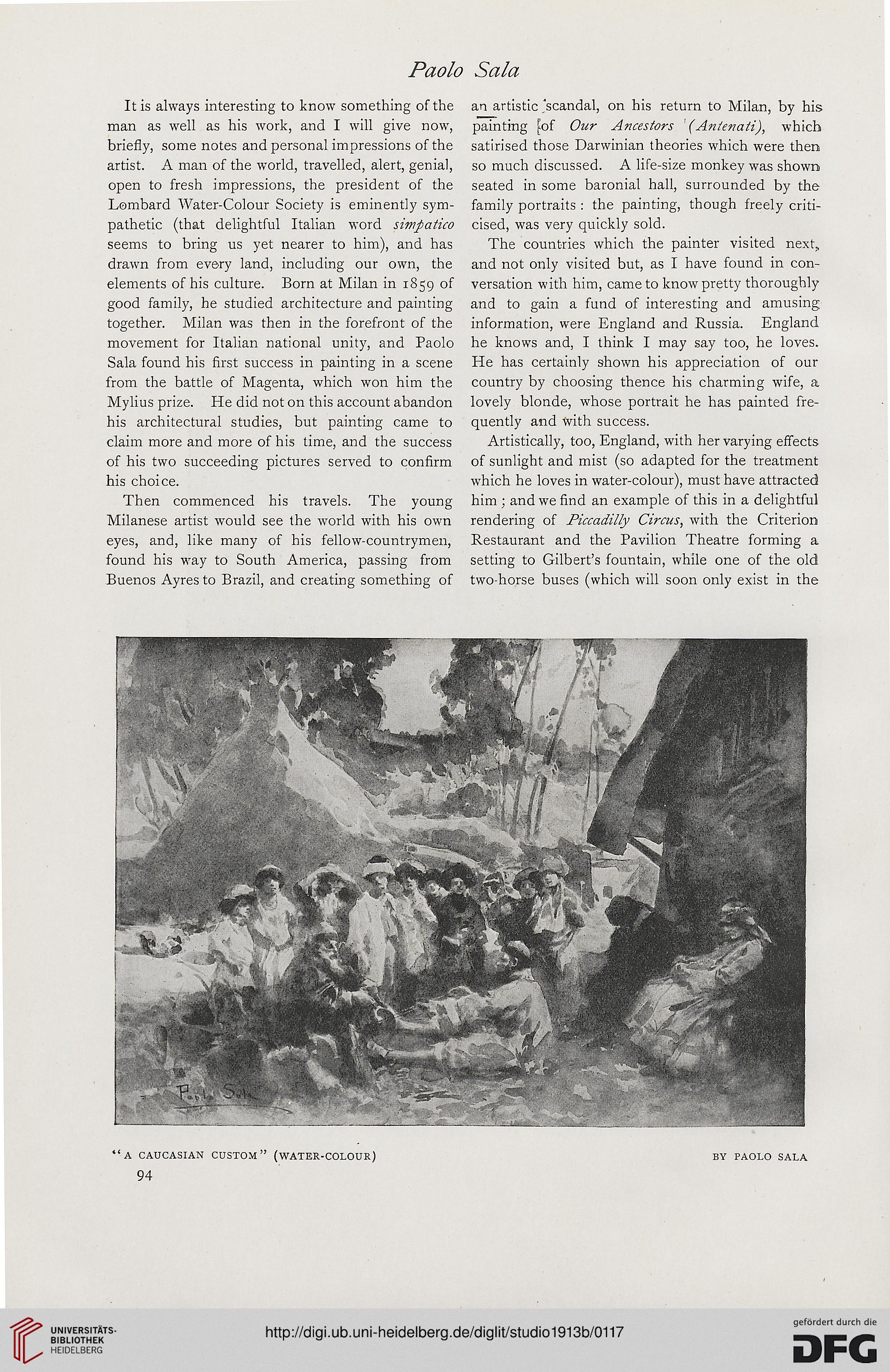Paolo Sala
It is always interesting to know something of the
man as well as his work, and I will give now,
briefly, some notes and personal impressions of the
artist. A man of the world, travelled, alert, genial,
open to fresh impressions, the president of the
Lombard Water-Colour Society is eminently sym-
pathetic (that delightful Italian word simpatico
seems to bring us yet nearer to him), and has
drawn from every land, including our own, the
elements of his culture. Born at Milan in 1859 of
good family, he studied architecture and painting
together. Milan was then in the forefront of the
movement for Italian national unity, and Paolo
Sala found his first success in painting in a scene
from the battle of Magenta, which won him the
Mylius prize. He did not on this account abandon
his architectural studies, but painting came to
claim more and more of his time, and the success
of his two succeeding pictures served to confirm
his choice.
Then commenced his travels. The young
Milanese artist would see the world with his own
eyes, and, like many of his fellow-countrymen,
found his way to South America, passing from
Buenos Ayres to Brazil, and creating something of
an artistic "scandal, on his return to Milan, by his
painting [of Our Ancestors ' (Antenati), which
satirised those Darwinian theories which were then
so much discussed. A life-size monkey was shown
seated in some baronial hall, surrounded by the
family portraits : the painting, though freely criti-
cised, was very quickly sold.
The countries which the painter visited next,
and not only visited but, as I have found in con-
versation with him, came to know pretty thoroughly
and to gain a fund of interesting and amusing
information, were England and Russia. England
he knows and, I think I may say too, he loves.
He has certainly shown his appreciation of our
country by choosing thence his charming wife, a
lovely blonde, whose portrait he has painted fre-
quently and with success.
Artistically, too, England, with her varying effects
of sunlight and mist (so adapted for the treatment
which he loves in water-colour), must have attracted
him ; and we find an example of this in a delightful
rendering of Piccadilly Circus, with the Criterion
Restaurant and the Pavilion Theatre forming a
setting to Gilbert's fountain, while one of the old
two-horse buses (which will soon only exist in the
"A CAUCASIAN CUSTOM" (WATER-COLOUR)
94
BY PAOLO SALA
It is always interesting to know something of the
man as well as his work, and I will give now,
briefly, some notes and personal impressions of the
artist. A man of the world, travelled, alert, genial,
open to fresh impressions, the president of the
Lombard Water-Colour Society is eminently sym-
pathetic (that delightful Italian word simpatico
seems to bring us yet nearer to him), and has
drawn from every land, including our own, the
elements of his culture. Born at Milan in 1859 of
good family, he studied architecture and painting
together. Milan was then in the forefront of the
movement for Italian national unity, and Paolo
Sala found his first success in painting in a scene
from the battle of Magenta, which won him the
Mylius prize. He did not on this account abandon
his architectural studies, but painting came to
claim more and more of his time, and the success
of his two succeeding pictures served to confirm
his choice.
Then commenced his travels. The young
Milanese artist would see the world with his own
eyes, and, like many of his fellow-countrymen,
found his way to South America, passing from
Buenos Ayres to Brazil, and creating something of
an artistic "scandal, on his return to Milan, by his
painting [of Our Ancestors ' (Antenati), which
satirised those Darwinian theories which were then
so much discussed. A life-size monkey was shown
seated in some baronial hall, surrounded by the
family portraits : the painting, though freely criti-
cised, was very quickly sold.
The countries which the painter visited next,
and not only visited but, as I have found in con-
versation with him, came to know pretty thoroughly
and to gain a fund of interesting and amusing
information, were England and Russia. England
he knows and, I think I may say too, he loves.
He has certainly shown his appreciation of our
country by choosing thence his charming wife, a
lovely blonde, whose portrait he has painted fre-
quently and with success.
Artistically, too, England, with her varying effects
of sunlight and mist (so adapted for the treatment
which he loves in water-colour), must have attracted
him ; and we find an example of this in a delightful
rendering of Piccadilly Circus, with the Criterion
Restaurant and the Pavilion Theatre forming a
setting to Gilbert's fountain, while one of the old
two-horse buses (which will soon only exist in the
"A CAUCASIAN CUSTOM" (WATER-COLOUR)
94
BY PAOLO SALA




